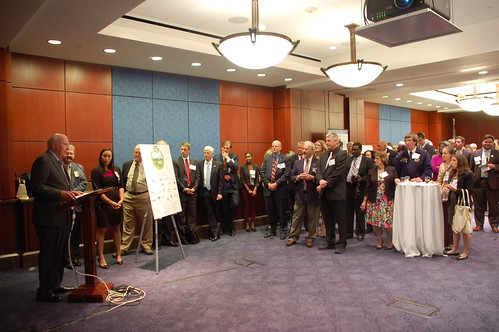
Patrick Leahy is Vermont’s senior U.S. senator and led in authoring forest conservation programs that he first included in the 1990 Farm Bill, when he chaired the Senate Committee on Agriculture, Nutrition, and Forestry. Robert Bonnie is USDA’s undersecretary for natural resources and environment. This week they headed a commemoration on Capitol Hill of this year’s 25th anniversary of the Forest Legacy Program and other initiatives that help states and communities conserve forest land. Wayne Maloney, Office of Communications
Twenty-five years ago, the Senate’s 1990 Leahy-Lugar Farm Bill authorized the creation of three pivotal forestry programs that today are a resounding success. The Forest Legacy, Forest Stewardship and Urban and Cooperative Forestry Programs help private and state forest landowners keep their forests healthy. That in turn supports tens of thousands of jobs, benefiting rural and urban communities across the nation. This week we joined in a celebration in the Capitol Hill Visitors Center marking this milestone.
These programs have made a big difference in the Green Mountain State. Last year, for example, USDA helped fund Vermont Forest Legacy projects that will conserve critical forestlands in the Groton Forest Legacy Initiative and the Windham Region Working Forest.
These two projects when completed will conserve more than 11,600 acres of forestland in Vermont that will permanently protect wildlife habitat and wildlife corridors. These projects also preserve public access, including hiking, hunting, fishing, cross-country skiing and designated trails for snowmobiles. The Forest Legacy Program by now has conserved more than 80,000 acres on 65 tracts in 16 different projects in Vermont since 1993. Projects like these are critical; although Vermont is the fourth most forested state, a report to the Vermont General Assembly this month finds that forest fragmentation is accelerating and forest cover is declining and recommends continued strategic investments in land conservation.
The Forest Legacy program has also had a big impact nationwide. Nearly two and a half million acres of working forests — equivalent in size to two Delawares — have been permanently conserved through the Forest Legacy Program. 53 states and territories today are participating in Forest Legacy. This program is particularly important in states like Vermont where the largest portion of forest land, 80 percent, is privately owned and, unless conserved, is subject to development.
Funded through the Land and Water Conservation Fund, which expires in September unless it is reauthorized by Congress, Forest Legacy focuses on the voluntary protection of working forests — those that provide forest products and recreational opportunities that keep rural economies vibrant.
The Forest Stewardship Program partners with state forestry agencies with a variety of programs to support private forest-owner planning and management efforts, including tree improvement and seedling production, and landowner education programs. Active in 50 States and six territories, since 1990, the program has funded more than 225,000 management plans encompassing approximately 25 million acres of private forests.
For tens of millions of Americans, the forests they know best are urban forests: urban parks, street trees, public gardens, river and coastal promenades and city greenways. Urban forests work hard cleaning air and water, helping to control stormwater runoff, conserving energy, providing recreation spaces, and providing beauty and economic value to their communities. The Urban and Community Forestry Program plays a central role in the management of 100 million acres of forests where more than 83 percent of Americans live, work and play. In Vermont this program has helped to train more than 500 Vermonters to be local urban and community forestry leaders and citizen-scientists who advise and advocate for the planting, protection and maintenance of their trees and forests. Each year these Vermonters donate more than 10,000 hours of service. Although Vermont is one of the most rural states, our local communities have benefited greatly from this program, which has helped to deliver crucial one-on-one technical assistance to local communities. Last year alone 93 Vermont communities were able to receive assistance under this program.
Twenty-five years ago Congress understood the need to focus efforts on protecting our working forests. Today we understand with even greater clarity the need to keep our forests healthy, resilient and intact, to help address large-scale issues of reducing wildfire risk, maintaining rural jobs, protecting watersheds and protecting at-risk species.
We are proud partners in this important work that helps keep our working forests working.
